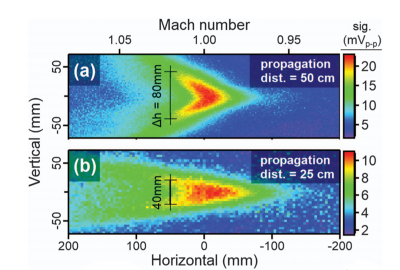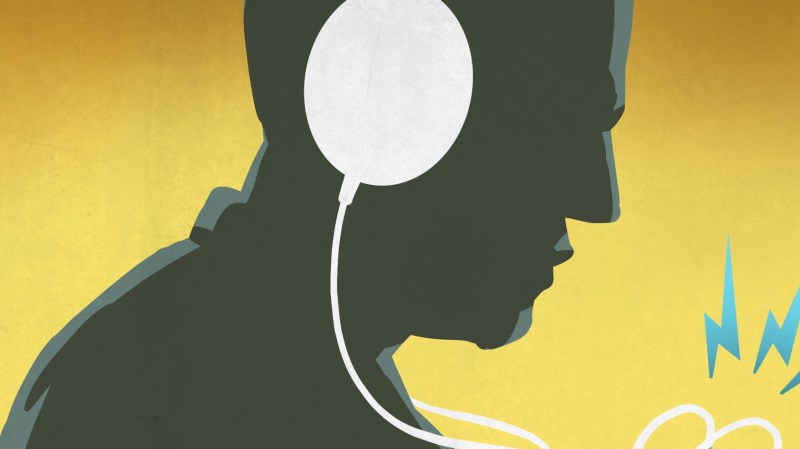What if I told you that you can get rid of your headphones and still listen to music privately, just by shooting lasers at your ears?
The trick here is something called the photoacoustic effect. When certain materials absorb light — or any electromagnetic radiation — that is either pulsed or modulated in intensity, the material will give off a sound. Sometimes not much of a sound, but a sound. This effect is useful for spectroscopy, biomedical imaging, and the study of photosynthesis. MIT researchers are using this effect to beam sound directly into people’s ears. It could lead to devices that deliver an audio message to specific people with no hardware on the receiving end. But for now, ditching those AirPods for LaserPods remains science fiction.
There are a few mechanisms that explain the photoacoustic effect, but the simple explanation is the energy causes localized heating and cooling, the material microscopically expands and contracts, and that causes pressure changes in the sample and the surrounding air. Saying pressure waves in air is just a fancy way of explaining sound.
Demonstrating a Proof of Concept
 In the case of the MIT project, a 1.9 μm thulium laser produces a beam tuned to water vapor at power levels that are not harmful to your eyes. The water vapor around your ears — and there is almost always some — absorbs the laser and generates sound. The team used both a modulated beam and a pulsed beam. In the pulsed beam case, the laser actually sweeps across your ear at the desired audio frequency.
In the case of the MIT project, a 1.9 μm thulium laser produces a beam tuned to water vapor at power levels that are not harmful to your eyes. The water vapor around your ears — and there is almost always some — absorbs the laser and generates sound. The team used both a modulated beam and a pulsed beam. In the pulsed beam case, the laser actually sweeps across your ear at the desired audio frequency.
Each method has advantages and disadvantages. Modulated light creates a higher fidelity sound. However, the sweeping technique produces louder sound and only creates the correct frequency at a certain distance from the laser. The team thinks that could be used to target specific people. Presumably, people nearby might still hear sounds, but at the wrong frequencies.
So far, this is more or less a lab demonstration. They’ve projected sound about 2.5 meters away of sufficient volume to hear with just your ear. We are guessing there are a host of practical problems to overcome to make this a workable system. Just targeting a specific person’s ear is probably nontrivial.
Nearly As Old as the Phone
Turns out the photoacoustic effect was known as early as 1880 while Alexander Graham Bell was working on his photophone which used sunlight to transmit speech. That device had a receiver that used a light sensor, but he noticed that he could produce sound waves just by hitting a solid object with pulsed sunlight and the frequency depended on the type of material. This eventually led to the spectrophone. However, with the crude sensors and light sources available, it was never really practical. Today, though, it is used for a variety of medical and biological tests.
This isn’t the first time I’ve written about MIT’s photoacoustic work. They’ve used it for spectroscopy that can detect gasses at a distance. Of course, if you are willing to allow a receiver, sending audio with a laser isn’t hard at all.
Honestly, we were a little surprised at how simple this looks and we wondered why we haven’t seen any homebrew projects that use this effect for something. Sure, a good spectroscope probably requires a tunable laser, but it would be interesting to see what kind of hobby-level projects could use gas and a laser to create sound. If you build something, be sure to tell us about it.
















Hopefully the lasers won’t ignite ear wax!
B^)
Plus side, there’s no need to trim your ear hair!
Countdown to ARPA crowd control proposal is now active
“So this is unblockable, right?”
“Well you could block it with anything that blocks light, but where would a crowd find something like that?”
“…riiiiight, don’t call us, we’ll call you.”
“The team thinks that could be used to target specific people. ”
You know, if you feed back what a person is saying with a half second delay, it confuses the hell out of them.
Now, just imagine doing that to a person speaking in public…
I had a 500msec. delay in my Internet as I was reading your message and am totally confused now.
:cough:
Maybe don’t put that as the title, unfortunately there are people who will LITERALLY believe it.
” The water vapor around your ears — and there is almost always some — absorbs the laser and generates sound. ”
Now I know where “wet behind the ears” comes from.
But I imagine this as a great supplement to Minority Report’s eye scanning-here’s your personalized ad.
If this is based on reacting with water vapor and low-power lasers for safety, I wonder if it would work in high humidity areas. Where I live (in the US), it’s pretty much never below 60% humidity in the winter, with the norm being more than 75% and about 100% for most of the summer. I wonder if this would still work then.
Might be able to do video with that density.
Indoor humidity is generally way lower, <10% right now in the winter in cold climates. I doubt that is enough moisture in the air for any practical levels. They only got 30dB, according to the article, which is about a factor of 100 lower than conversational.
Good luck trying to miniaturize a thulium laser
You don’t need a laser to do this. An infrared high-power LED works just fine — one watt peak power is (just) enough. You just have to keep the pulse length short (a few dozen microseconds), and the range very short (a centimeter or so).
You can try it yourself quickly with a normal hotshoe-type photoflash: fire it manually aimed at a a black piece of paper or metal, and compare the sound to a similar white piece. The difference in the sound you hear is the photoacoustically-generated sound from the light being absorbed by the target material.
A photoflash pulse length is a few milliseconds, so limits the audible spectrum to a few hundred hertz. That’s why you want the LED to generate pulses of a few dozen microseconds: you need it short enough to generate a useful audio spectrum, but long enough to deposit an audible amount of energy.
And if you’re really adventurous, pulsed microwave does the same neat trick, and has the advantage of being absorbed by the whole brain. The voices really can come from inside your head.
Nice. What’s that sizzling sound?
B^)
Now that I think about it, blue LEDs have become much more powerful, efficient and cheap since I did it with IR LEDs (a decade or so ago). Blue light is absorbed (much) more strongly in tissue, so it’s likely to be more effective in converting into sound. Time to troll digikey for high power blue LEDs…
How did you fit your head in your K40? Do you need 2 for stereo, or will they meet in the middle and burn your brains out?
The sizzling sound leads me to think thermal noise or otherwise called, “popcorn”
Seems like there needs to be a feedback mechanism also to range the target and then adjust intensity to be safer. Can even add some sort of target and environmental specific correction… system and/or algorithm.
Dropping a link here regarding lasers for long range biometric analysis and might even be worth it’s own article: https://www.technologyreview.com/s/613891/the-pentagon-has-a-laser-that-can-identify-people-from-a-distanceby-their-heartbeat